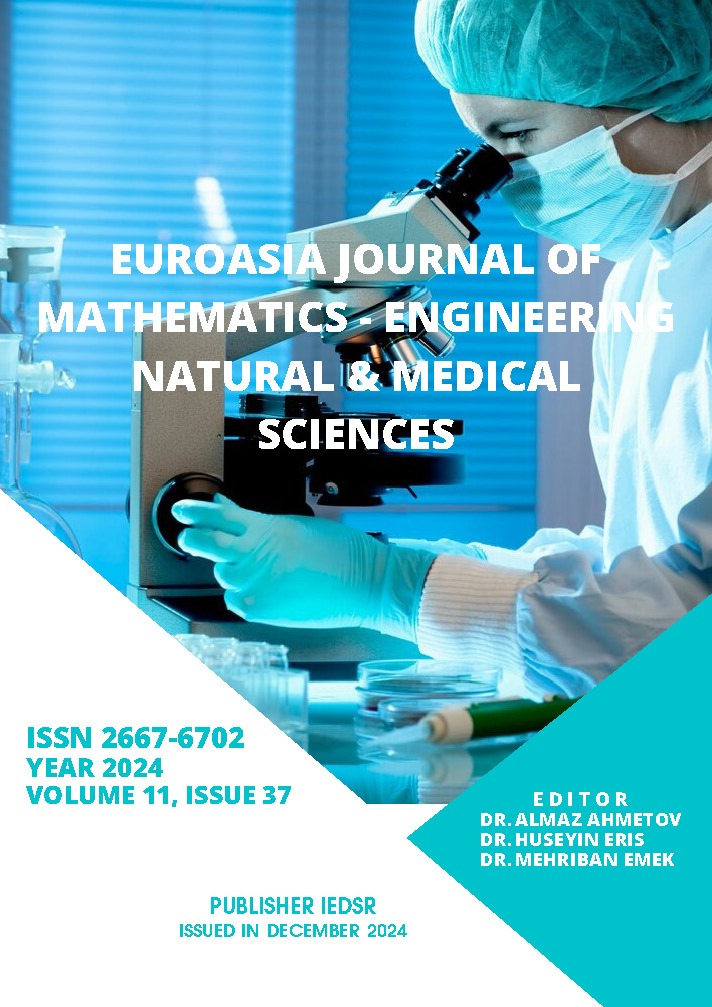Synthesis, Spectroscopic, Thermal and Structural Properties of Mixed Ligand Mercury(II) Saccharin Complexes with Piperazine and 1-(2-Aminoethyl)Piperazine
DOI:
https://doi.org/10.5281/zenodo.14569182Keywords:
Piperazine, 1-(2-aminoethyl)piperazine, Saccharin ComplexesAbstract
Two new Hg(II) complexes of the saccharinate (sac) anion with piperazine (ppz) and N-(2-aminoethyl)piperazine (aeppz), namely [Hg(sac)₂(ppz)]ₙ (1) and [Hg(sac)₂(aeppz)₂] (2), have been synthesized. The structures of these complexes were characterized through various techniques, including elemental analysis, FT-IR spectroscopy, TGA/DTA, UV-Vis spectroscopy, and magnetic susceptibility measurements. The synthesis of the complexes was achieved through the reaction of [Hg(sac)2] with the ligands ppz and aeppz. In complex 1, it is suggested that the sac ligand coordinates to the Hg(II) ion through its N atom, while the ppz ligand facilitates bridging coordination between two Hg(II) ions through its N atoms. In complex 2, it is proposed that the sac ligand coordinates in a monodentate manner through its carbonyl O atom, whereas the aeppz ligand acts as a bidentate ligand by utilizing its ring and aminoethyl N atoms. The IR spectrum of the complexes displays the characteristic absorption bands of the ppz, aeppz, and sac ligands. In the thermal decomposition of complex 1, the ppz ligand is exothermically removed in the first stage, while the sac ligand decomposes in two exothermic steps at higher temperatures, leaving elemental mercury to evaporate. In the thermal decomposition of complex 2, one aeppz ligand is removed in two steps, one exothermic and one endothermic, while the sac ligand decomposes in two exothermic stages at higher temperatures.
References
Ager, D. J., Pantaleone, D. P., Henderson, S. A., Katritzky, A. L., Prakash, I., Walters, D. E. (1998). Commercial, Synthetic Nonnutritive Sweeteners. Angewandte Chemie International Edition, 37, 1802.
Baran, E.J. (2005). The Saccharinate Anion: A Versatile And Fascinating Ligand in Coordination Chemistry. Química Nova, 28(2), 326-328.
Ulukaya, E., Ari, F., Dimas, K., İkitimur, E.I., Guney, R., Yılmaz, V.T. (2011). Anti-cancer activity of a novel palladium(II) complex on human breast cancer cells in vitro and in vivo. European Journal of Medicinal Chemistry, 46, 4957-4963.
Ari, F., Ulukaya, E., Sarimahmut, M., Yilmaz, V.T. (2013). Palladium(II) saccharinate complexes with bis(2-pyridylmethyl)amine induce cell death by apoptosis in human breast cancer cells. Bioorganic & Medicinal Chemistry, 21, 3016-3021.
Ari, F., Cevatemre, B., Ikitimur Armutak, E.I., Aztopal, N., Yilmaz, V.T., Ulukaya, E. (2014). Apoptosis-inducing effect of a palladium(II) saccharinate complex of terpyridine on human breast cancer cells in vitro and in vivo. Bioorganic & Medicinal Chemistry, 22, 4948-4954.
Al-Jibori, S.A., Al-Jibori, G.H., Al-Hayaly, L.J., Wagner, C., Schmidt, H., Timur, S., Barlas, F.B., Subasi, E., Ghosh, S., Hogar, G. (2014). Combining anti-cancer drugs with artificial sweeteners: Synthesis and anti-cancer activity of saccharinate (sac) and thiosaccharinate (tsac) complexes cis-[Pt(sac)2(NH3)2] and cis-[Pt(tsac)2(NH3)2]. Journal of Inorganic Biochemistry, 141, 55-57.
Suen, M.C., Keng, T.C., Wang, J.C. (2002). One-dimensional structures of zinc(II) and cobalt(II) coordination complexes [Zn(NCS)2(PPz)]n and [CoCl2(PPz)]n (PPz=piperazine). Polyhedron, 21, 2705-2710.
Ganesan, S.V., Natarajan, S. (2004). Synthesis and Structures of New Pyromellitate Coordination Polymers with Piperazine as a Ligand. Inorganic Chemistry, 43(1), 198-205.
Zhao, X.-J., Du, M., Wang, Y., Bu, X.-H. (2004). Formation of cobalt(II)–piperazine supramolecular systems under different organic acid mediums: synthesis, characterization and crystal structures. Journal of Molecular Structure, 692, 155-161.
Nolte, M., Pantenburg, I., Meyer, G. (2005). Three Piperazine Complexes of Divalent Mercury: Hg(CF3)2(Pip), Hg(SCN)2(Pip), and (Hg(SCN)2)2(Pip). Zeitschrift für anorganische und allgemeine Chemie, 631, 2923-2927.
Xu, H., Song, Y.L., Mi, L.W., Hou, H.W., Tang, M.S., Sang, Y.L., Fan, Y.T., Pan, Y. (2006). Coordination frameworks constructed from bipyridyl piperazine and MCl2 (M = Co, Ni, Zn): structural characterization and optical properties. Dalton Transactions, 838-845.
Al-Ghorbani, M., Bushra, B.A., Mamatha, S.V., Khanum, S.A. (2015). Piperazine and morpholine: synthetic preview and pharmaceutical applications. Research Journal of Pharmacy and Technology, 8(5), 611-628.
Sharma, P.C., Jain, A., Jain, S., Pahwa, R., Yar, M.S. (2010). Ciprofloxacin: review on developments in synthetic, analytical, and medicinal aspects. Journal of Enzyme Inhibition and Medicinal Chemistry, 25(4), 577-589.
Kaur, H., Singh,,R., Rishikant. (2022). Synthesis, Molecular Docking, and Antitubercular Evaluation of Triazole–Chalcone Conjugates. Russian Journal of Organic Chemistry, 58(4), 518-525.
Limberg, C., Ostermeier, M., Herwig, C., Ziemer, B. (2009). Stabilizing the Boat Conformation of Piperazines Coordinated to Iron(II): iso-Butyl Substituents Lead to Robust Oxidation Catalysts via Hyperconjugation. Zeitschrift für anorganische und allgemeine Chemie, 635, 1823-1830.
Brito, A.F., Moreira, L.K., Menegatti, R., Costa, E.A. (2019). Piperazine derivatives with central pharmacological activity used as therapeutic tools. Fundamental & clinical pharmacology, 3 (1), 13-24.
Aggarwal, N., Kant, R., Kumar, G., James, C., Maji, S. (2020). Synthesis, characterization and biological evaluation studies of Cu (II) and Zn (II) complexes with gly-o-andn or gly-p-andn as primary ligand and N, N'donors as secondary ligand. Journal of Physics: Conference Series., 1531(1), 012111.
Kant, R., Saini, R., Kaur, M., Karnwal, A., Rather, H.A., Maji, S. (2022). Synthesis and characterization of copper complexes of phenylpiperazine ring-based ligands and evaluation of their antimicrobial, BSA binding, computational, and molecular docking studies, Journal of Physics: Conference Series., 2267(1), 012154.
Zhang, Y.-P., Li, Y., Xu, G.-C., Li, J.Y., Luo, H.Y., Li, J.Y., Zhang, L., Jia, D.Z. (2019). Synthesis, crystal structure, DNA/bovine serum albumin binding and antitumor activity of two transition metal complexes with 4-acylpyrazolone derivative. Applied Organometalic Chemistry, 33(3), e4668.
Neelakantan, M.A., Balamurugan, K., Balakrishnan, C., Subha, L. (2018). Interaction of amino acid schiff base metal complexes with DNA/BSA protein and antibacterial activity: spectral studies, DFT calculations and molecular docking simulations. Applied Organometalic Chemistry, 32(4), e4259.
Yılmaz, V.T., Güney, S., Kazak, C., (2008). Copper(II)-saccharinato complexes with piperazine and N-(2-aminoethyl)piperazine ligands, Polyhedron, 27, 1381-1386.
Güney, S., Yılmaz, V.T., Harrison, W.T.A., (2005). Synthesis, crystal structure, spektroskopic and thermal properties of trans-[Ni(sac)2(aeppz)2] [sac = saccharinate and aeppz = N-(2-aminoethyl)piperazine], Journal of Coordination Chemistry, 58, 1667-1674.
Yılmaz, V.T., Güney, S., Harrison, W.T.A., (2005). trans-Bis(saccharinato)zinc and –cadmium Complexes with N-(2-aminoethyl)piperazine: Synthesis, Crystal Structures and IR Spectra, Zeitschrift für Naturforschung, 60b, 403-407.
Downloads
Published
How to Cite
Issue
Section
License
Copyright (c) 2024 Euroasia Journal of Mathematics, Engineering, Natural & Medical Sciences

This work is licensed under a Creative Commons Attribution-NonCommercial 4.0 International License.

